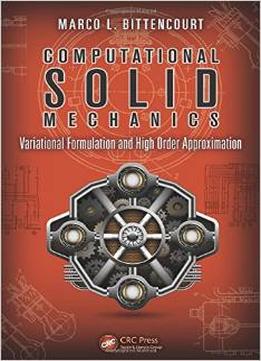
Computational Solid Mechanics: Variational Formulation And High Order Approximation
by Marco L. Bittencourt /
2014 / English / PDF
15.2 MB Download
Presents a Systematic Approach for Modeling Mechanical Models Using Variational Formulation—Uses Real-World Examples and Applications of Mechanical Models Utilizing material developed in a classroom setting and tested over a 12-year period, Computational Solid Mechanics: Variational Formulation and High-Order Approximation details an approach that establishes a logical sequence for the treatment of any mechanical problem. Incorporating variational formulation based on the principle of virtual work, this text considers various aspects of mechanical models, explores analytical mechanics and their variational principles, and presents model approximations using the finite element method. It introduces the basics of mechanics for one-, two-, and three-dimensional models, emphasizes the simplification aspects required in their formulation, and provides relevant applications. Introduces Approximation Concepts Gradually throughout the Chapters Organized into ten chapters, this text provides a clear separation of formulation and finite element approximation. It details standard procedures to formulate and approximate models, while at the same time illustrating their application via software. Chapter one provides a general introduction to variational formulation and an overview of the mechanical models to be presented in the other chapters. Chapter two uses the concepts on equilibrium that readers should have to introduce basic notions on kinematics, duality, virtual work, and the PVW. Chapters three to ten present mechanical models, approximation and applications to bars, shafts, beams, beams with shear, general two- and three-dimensional beams, solids, plane models, and generic torsion and plates. Learn Theory Step by Step In each chapter, the material profiles all aspects of a specific mechanical model, and uses the same sequence of steps for all models. The steps include kinematics, strain, rigid body deformation, internal loads, external loads, equilibrium, constitutive equations, and structural design. The text uses MATLAB® scripts to calculate analytic and approximated solutions of the considered mechanical models. Computational Solid Mechanics: Variational Formulation and High Order Approximation presents mechanical models, their main hypothesis, and applications, and is intended for graduate and undergraduate engineering students taking courses in solid mechanics.











